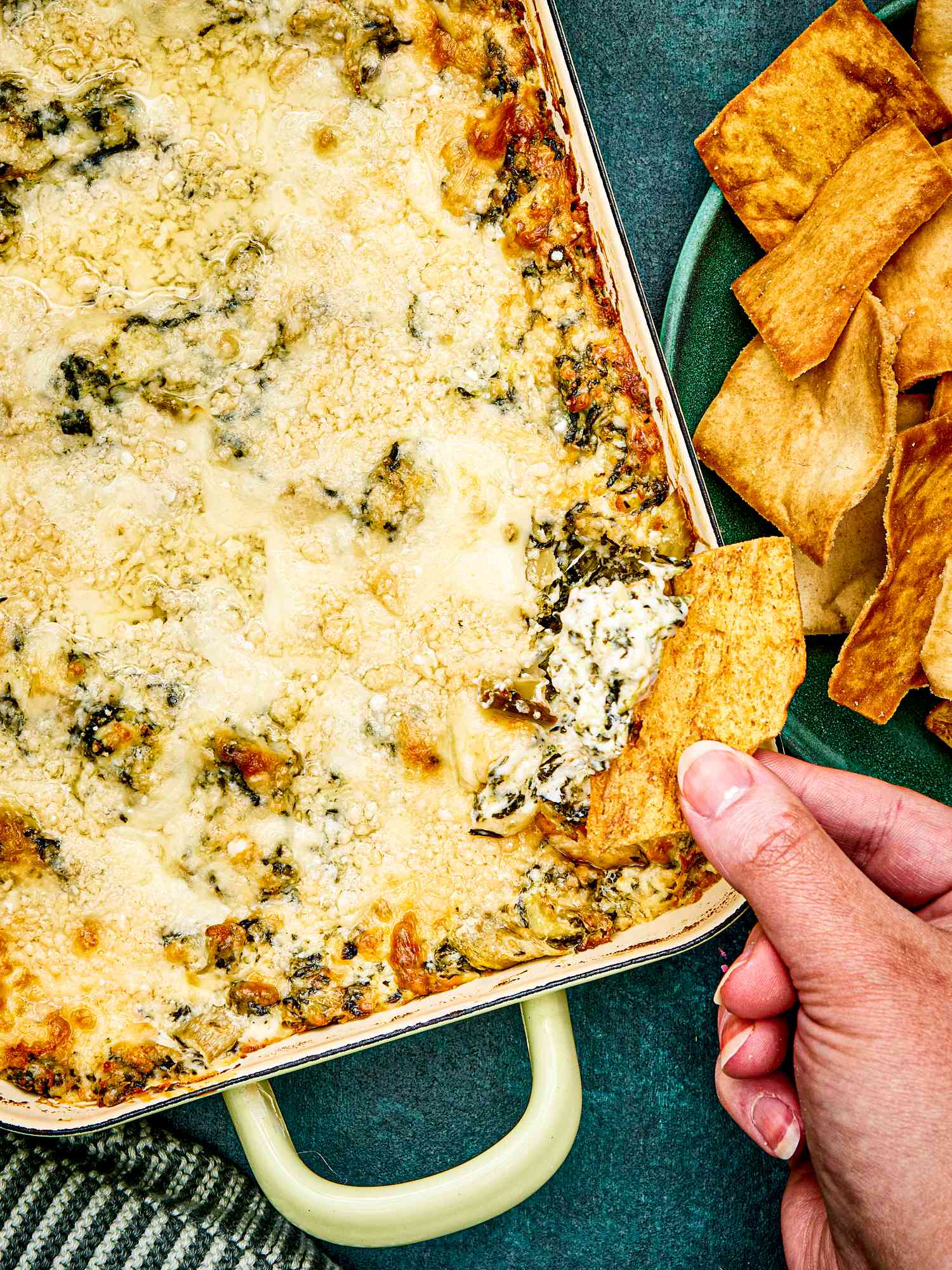Why It Works
- A blend of mayonnaise, sour cream, and cream cheese creates the dip’s signature thick, smooth texture.
- Starting with frozen cut-leaf spinach saves on prep time without skimping on flavor.
- Baking the dip in a glass or ceramic baking dish at a steady moderate temperature ensures the dip remains creamy and cohesive once cooked through.
Rich creamy dips are one of life’s greatest pleasures, and the old party stalwart, spinach-artichoke dip, is among the best. As a child of the 90s, I’ve enjoyed countless bowls of spinach dip at parties, as well as my fair share of sizzling cast iron skillets of the iconic dip at chain restaurants like TGI Fridays. It’s a bonafide crowd pleaser and edible proof that the only thing better than plain mayonnaise is mayonnaise bubbling with cheese and chunks of savory spinach and chopped artichoke hearts.
While it’s a beloved restaurant staple, I’d argue that the best version of spinach-artichoke dip is enjoyed fresh out of the oven at home, where you have total control over the ingredients. And that ratio of ingredients needs to be perfect: There’s nothing worse than scooping up a bite of dip and winding up with too much spinach, not enough artichoke, or worse, a dip with a grainy or greasy texture. Our recipe nails the perfect proportions of spinach to artichokes and uses a blend of cream cheese, mayo, and sour cream with a mixture of cheese to create the ultimate creamy texture and balanced flavor. If you’re looking to perfect this party dip for your next gathering or game-day spread, or even just a cozy night in, here’s what you need to know to get it right.
Serious Eats/Morgan Hunt Glaze
Tips for Rich Creamy Spinach Artichoke Dip
Use a trifecta of creamy ingredients for the richest dip possible. Many versions of spinach-artichoke dip call for just one creamy ingredient (often mayonnaise or cream cheese) to fold into the cheese mixture before baking. But we didn’t hold back here: This recipe calls for mayonnaise, sour cream, and cream cheese for the richest, creamiest dip possible. On top of the silky texture each of these three ingredients has, they each add a slightly different tangy note for a flavor that’s both nuanced and cohesive.
Double down on cheese. Monterey jack cheese or a mild white cheddar cheese melt easily into the dip when baked, and their mild flavor is balanced by sharp, nutty, and assertive Parmesan cheese.
Add lemon zest, garlic, and Dijon mustard to balance the rich, creamy base. This dip is rich, there’s no skirting around it. But it needs a few bright additions to balance it out, so you’ll want to eat bite after bite. A small amount of lemon zest, fresh garlic, and Dijon mustard perk it up nicely. We also love the savory appeal that one tablespoon of white miso adds to the dip, but feel free to omit it if you don’t have miso on hand.
Serious Eats/Morgan Hunt Glaze
Stick with frozen spinach but make sure its the right cut. We started testing the recipe with fresh spinach, as we assumed the old adage “fresh is best” would ring true here. But while we loved the idea and the look of the dip made with vibrant green fresh spinach, the added steps of chopping, cooking, and wringing out the excess moisture from the spinach was not worth the effort. The flavor of the fresh spinach versus frozen was almost indistinguishable once mixed into the cheese-laden dip. Make sure to use frozen spinach labeled “cut-leaf” and not “chopped.” Frozen chopped spinach is too finely chopped and creates a mealy texture in the dip. Meanwhile, frozen cut-leaf spinach is the perfect size for scooping onto veggies and chips.
Go with canned artichokes. The outcome was similar when comparing fresh artichokes to canned artichokes in this recipe. It was silly to take the time and labor to prep fresh artichokes just to mask their flavor in a cheesy dip. Fresh artichokes are glorious and have their time and place, but this dip is not one of them. So stick with canned artichokes, rinse them well to remove excess salt, and chop them into bite-size, scoopable bits.
Bake at a steady moderate heat. When attempting to bake and melt a large amount of cheese and cream into a cohesive mixture, you want to avoid heating the mixture too quickly or at to too high a temperature. This can cause the cheese and dairy to separate, leaving you with pools of leached fat swimming on top of the dip. To avoid this greasy mess, bake the dip at a steady moderate temperature. Do not be tempted to speed up the baking process by raising the oven temperature.
Skip the cast iron. Another way to avoid an unpleasant separated dip is to choose the right pan for baking. When seasoned recipe developer Julia Levy was developing this recipe in the test kitchen, she started by baking the dip in a cast iron skillet. She assumed the cast iron’s great heat retention properties would keep the dip warm for longer when left out to enjoy (which it did). But she found that the cast iron skillet’s heat retention overheated the dip, even when baked at a moderate temperature, causing the dip to break. We wished that wasn’t the case since, as Julia noted, the skillet was also just so cute! But because we here at Serious Eats are firm believers that a practical, foolproof recipe is more important than a cute “‘gram-worthy” presentation, we recommend baking it in a standard glass or ceramic baking dish.
Serious Eats/Morgan Hunt Glaze
This recipe was developed by Julia Levy; the headnote was written by Leah Colins.


